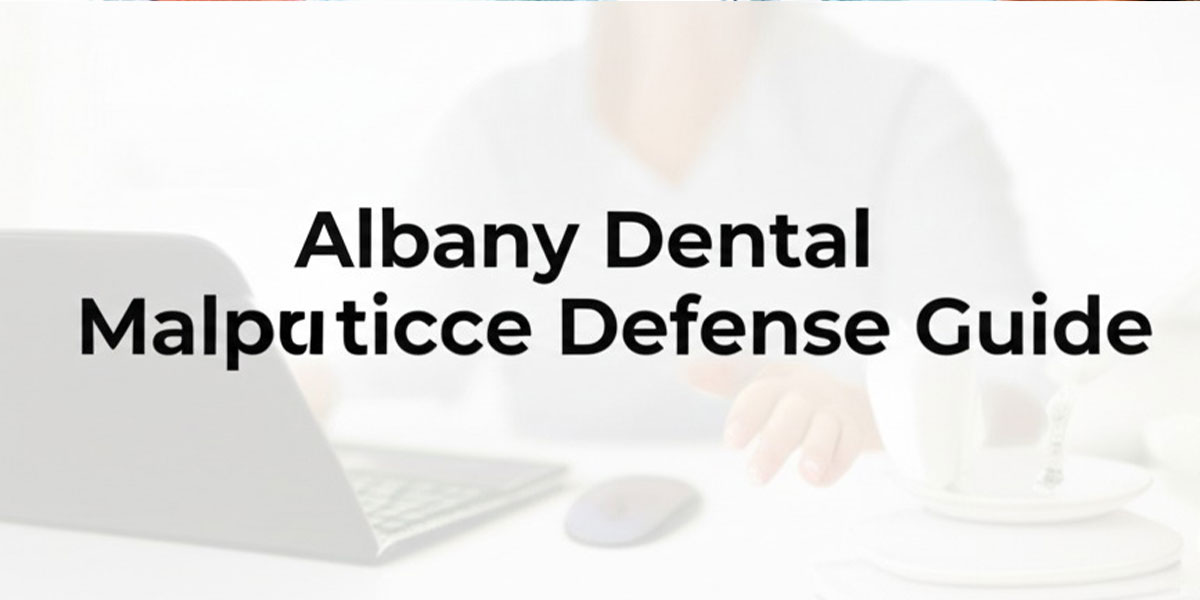Protecting Your Albany Dental Practice from Malpractice Claims
As an established dentist in Albany, New York, you have dedicated your career to providing exceptional patient care, building a trusted reputation, and growing a successful practice. The region’s demand for high-quality dental services is strong, and your commitment to excellence is the foundation of your business. However, even the most skilled and conscientious practitioners face a significant professional risk: the threat of a dental malpractice lawsuit. In today’s litigious environment, a single claim—whether justified or not—can jeopardize your license, harm your reputation, and create immense financial and emotional distress. Understanding the legal landscape of dental malpractice in New York is not just a matter of professional diligence; it is a critical component of a comprehensive risk management strategy designed to protect your life’s work.
In my 30+ years as a New York attorney, I have seen how legal challenges can unexpectedly disrupt thriving businesses. While my primary focus has been on asset protection through estate planning and business succession, the principles of risk mitigation are universal. A malpractice claim is a direct threat to the value and viability of your dental practice as a core asset. Therefore, a proactive defense strategy is essential. This guide will provide Albany dentists with a detailed overview of New York’s dental malpractice laws, including the critical elements a plaintiff must prove and the strict statutes of limitations. More importantly, it offers actionable advice on documentation, patient communication, and informed consent to fortify your practice against potential claims. We will also explore how experienced legal counsel can provide tailored defense strategies when you need them most.
Understanding the Legal Framework of Dental Malpractice in New York
A dental malpractice lawsuit is a specific type of negligence claim. It is not enough for a patient to be unhappy with the outcome of a procedure. To succeed in a malpractice lawsuit in New York, a patient (the plaintiff) must prove four specific elements by a preponderance of the evidence. These are often referred to as the “Four D’s” of negligence. Understanding these legal pillars is the first step in building an effective defense. It allows you to structure your practice’s protocols and documentation in a way that directly counters the arguments a plaintiff’s attorney would need to make. This knowledge empowers you to move from a reactive to a proactive stance in risk management.
The entire process is governed by a framework of statutes and case law that defines the responsibilities of healthcare providers. For any dental office Albany (visit us) operates, adherence to these standards is not optional. It is the bedrock upon which patient trust and legal defensibility are built. An allegation of a breach in this standard of care is the trigger for every malpractice claim, making a deep understanding of your obligations essential for every member of your team, from the front desk to the dental chair. A failure at any point in the patient care continuum can create a potential vulnerability.
The Four Elements of a Dental Malpractice Claim
For a malpractice claim to be successful, a plaintiff must legally establish all four of the following points. The failure to prove even one of these elements typically results in the dismissal of the case. A strong defense strategy involves creating and maintaining records that challenge a plaintiff’s ability to prove one or more of these pillars.
- Duty: The plaintiff must first prove that a dentist-patient relationship existed. This relationship establishes that you, the dentist, owed the patient a professional duty of care. This is usually the easiest element to prove, established by appointment records, treatment plans, and billing statements showing that the patient was under your professional care.
- Dereliction (or Breach) of Duty: This is the core of the malpractice claim. The plaintiff must demonstrate that you failed to meet the accepted “standard of care.” In New York, the standard of care is defined as the level of skill and care that a reasonably prudent dentist in the Albany area would have exercised under similar circumstances. It is not a standard of perfection. The plaintiff must use expert testimony from another dentist to argue that your actions fell below this professional benchmark.
- Direct Causation (or Proximate Cause): The plaintiff must then prove that your breach of the standard of care was the direct cause of their injury. It is not enough to show that a mistake was made and an injury occurred. There must be a clear link between the two. For example, if a poor crown placement directly led to a nerve injury, causation may exist. If the injury was due to an unrelated, underlying condition, causation would be difficult to prove.
- Damages: Finally, the plaintiff must prove they suffered actual harm or “damages” as a result of the injury. These damages can include the cost of corrective procedures, lost wages from time off work, and compensation for pain and suffering. Without demonstrable damages, there is no basis for a financial award, and thus no case.
New York’s Statute of Limitations for Dental Malpractice
A critical legal defense in malpractice cases is the statute of limitations. This is a law that sets a strict time limit on a patient’s right to file a lawsuit. In New York, under Civil Practice Law & Rules (CPLR) § 214-a, a patient generally has two years and six months to file a dental malpractice lawsuit. This time period typically begins to run from the date of the alleged malpractice (the “act or omission”) or from the end of a continuous course of treatment for the same condition. There are some exceptions, such as the “foreign object” rule, which allows a case to be filed within one year of discovering an object left in a patient’s body. Adhering to these deadlines is crucial, and a case filed even one day late can be dismissed. This legal principle underscores the importance of asset protection strategies, an area where the forward-thinking of New York estate planning provides valuable parallels for business owners.
Proactive Strategies to Mitigate Malpractice Risk
The most effective way to defend against a malpractice claim is to prevent it from ever being filed. A proactive risk management program, embedded in the daily operations of your practice, is your strongest shield. This involves much more than just having liability insurance. It requires a commitment to meticulous record-keeping, clear communication, and a culture of patient safety. These strategies not only reduce your legal risk but also enhance patient trust and improve clinical outcomes, strengthening your reputation as a premier dentist Albany (find us here) residents can rely on. These proactive steps are a form of business asset protection, a concept familiar to experts in crafting wills and trusts to safeguard wealth.
The Golden Rule: If It Isn’t Documented, It Didn’t Happen
In a courtroom, your patient records are your most credible witness. They provide a contemporaneous account of the care provided and the decision-making process behind it. Vague, incomplete, or altered records can be devastating to your defense. Legally defensible dental records should include:
- A Comprehensive Medical and Dental History: This should be updated at every visit. Document all allergies, medications, and pre-existing conditions that could impact treatment.
- Detailed Clinical Notes: For every visit, record the patient’s complaints, your objective findings, your diagnosis, the treatment provided, and any instructions given. Be specific and objective.
- Informed Consent Documentation: Maintain signed consent forms for all significant procedures, especially complex treatments like those provided by a cosmetic dentist albany (get directions).
- Records of All Communications: Document every phone call, email, and conversation with the patient, especially regarding post-operative care, missed appointments, or complaints.
This level of detail creates a powerful narrative that can refute allegations of negligence. Just as a probate court relies on meticulous documentation to execute an estate, a trial court relies on your records to understand the care provided. For guidance on organizing complex business records, the principles applied by a New York probate attorney can be surprisingly relevant.
Informed Consent: A Dialogue, Not a Document
Informed consent is a legal and ethical requirement, but it is also a powerful risk management tool. A signed form is necessary, but it is not sufficient on its own. The real value comes from the *process* of informed consent—a meaningful dialogue with the patient. Before any procedure, you must discuss the risks, benefits, and viable alternatives (including no treatment). This conversation should be documented in the patient’s chart. When patients understand the potential for complications, they are less likely to feel surprised or wronged if an adverse outcome occurs. This is particularly crucial for elective procedures with high patient expectations, such as advanced orthodontic treatments like invisalign albany (map to our office).
This process builds trust and manages expectations. In states like Florida, the legal standards for informed consent can have unique nuances. Business owners with practices in multiple states must be aware of these differences. A resource like Florida Attorneys Near Me can be invaluable for understanding these state-specific requirements. By ensuring your consent process is robust, you are not just fulfilling a legal duty; you are actively building your defense against future claims. The principle of full disclosure is as important here as it is in the fiduciary duties central to the work of a top NYC estate planning firm.
Structuring Your Practice for Enhanced Asset Protection
Beyond clinical protocols, the legal structure of your dental practice plays a critical role in risk management. How your business is organized can determine whether a malpractice judgment can threaten your personal assets, such as your home and savings. This is where clinical practice management intersects with strategic business law. The goal is to create a legal firewall between your professional liabilities and your personal wealth, a cornerstone of any sound financial plan. This strategy is essential for any professional, whether you are a dentist in Albany or an entrepreneur in Manhattan seeking advice from a firm like Morgan Legal Group.
In New York, dentists are required to form a specific type of legal entity, most commonly a Professional Service Corporation (P.C.) or a Professional Service Limited Liability Company (P.L.L.C.). These structures provide a significant benefit: they shield your personal assets from the business’s debts and liabilities, including general business lawsuits. However, it is a common misconception that they offer absolute protection from malpractice. While the corporate structure protects you from the malpractice of a partner or employee (unless you were directly supervising them), you remain personally liable for your own professional negligence. For comprehensive asset protection, a multi-layered approach involving both the correct corporate structure and adequate malpractice insurance is essential. A consultation with a business law attorney can help ensure your practice is structured for maximum protection.
The Importance of Adequate Malpractice Insurance
Professional liability insurance is your primary financial shield against a malpractice claim. It is crucial to not only have insurance but to have the right type and amount of coverage. There are two main types of policies:
- Occurrence Policies: These cover any incident that occurred during the policy period, regardless of when the claim is filed. This is often considered the more comprehensive and protective option.
- Claims-Made Policies: These only cover claims that are made and reported while the policy is in effect. If you retire or switch carriers, you must purchase “tail coverage” to remain protected from incidents that occurred while the policy was active.
Review your policy limits regularly with your insurance broker and legal advisor to ensure they are sufficient for the scope of your practice. For example, a cosmetic dentist albany (view our location) performing complex reconstructions may require higher limits than a general practitioner. Understanding these financial instruments is a key part of business ownership, similar to how Florida estate planning attorneys use trusts to shield assets.
When a Claim Arises: Navigating the Legal Process
Despite your best efforts, you may one day receive a letter from a patient’s attorney or a formal summons and complaint. Your actions in the first 24 hours are critical. The first and most important step is to contact your malpractice insurance carrier immediately. They will assign a defense attorney to represent you. Do not attempt to contact the patient or their attorney directly, as anything you say can be used against you. Do not, under any circumstances, alter the patient’s records after you have been notified of a potential claim. This is seen as an admission of guilt and can destroy your credibility.
Your assigned defense attorney will guide you through the litigation process, which can be long and stressful. It typically involves discovery (exchanging documents and taking depositions), settlement negotiations, and, if necessary, a trial. Throughout this process, your detailed records and clear communication protocols will become the foundation of your defense. A strong legal team will work to dismantle the plaintiff’s case, element by element. This is why connecting with trusted legal professionals, whether through a platform like Lawyer.Bet or a referral from a firm like Morgan Legal Group, is so critical. Having expert guidance provides not just a legal defense, but peace of mind. For those with business interests in other states, knowing where to find counsel, such as through the network of Florida business law attorneys, is equally important.
The Critical Role of Patient Communication in De-escalation
Many lawsuits are born from misunderstandings and poor communication. Patients who feel unheard, disrespected, or abandoned are far more likely to seek legal action. Implementing a practice-wide policy for handling patient complaints can de-escalate many situations before they reach a lawyer’s office. When a patient expresses dissatisfaction, listen empathetically, investigate their concerns thoroughly, and communicate your findings clearly and compassionately. While you should not admit fault, expressing empathy for their experience can go a long way. This patient-centric approach can transform a potential plaintiff into a loyal patient, safeguarding the reputation of your dental office Albany (see our practice) and protecting your bottom line.
This focus on clear communication and conflict resolution is a valuable skill in any professional setting. The most successful practitioners, whether they are a top dentist Albany (visit our office) or a leading attorney, understand that technical skill must be paired with emotional intelligence. It’s a principle that guides the best advisors in every field, from those handling complex procedures like invisalign albany (find us on the map) to those guiding families through sensitive probate proceedings. Taking the time to connect with your patients is one of the most effective, and least expensive, forms of risk management available. For a final check on your practice’s legal health, a consultation with experienced attorneys can provide invaluable insights, and for Florida matters, contacting a local firm is the prudent choice.




